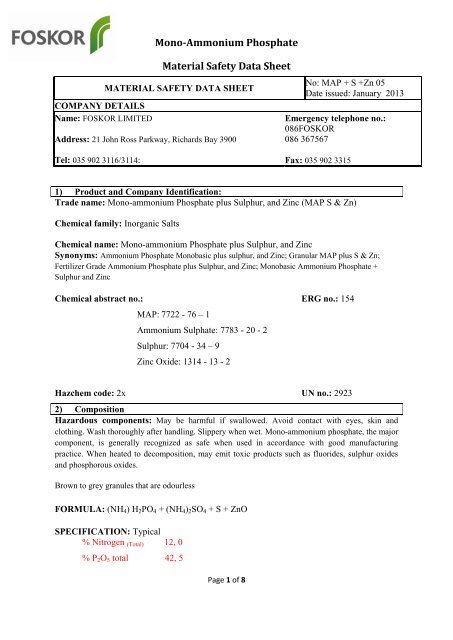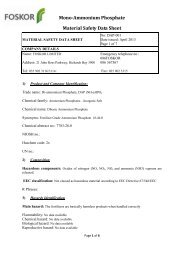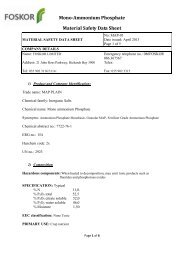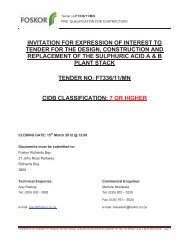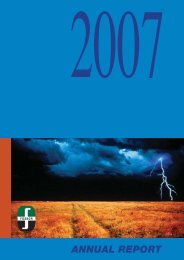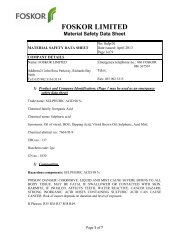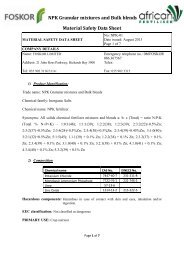MAP S & Zn - Foskor
MAP S & Zn - Foskor
MAP S & Zn - Foskor
You also want an ePaper? Increase the reach of your titles
YUMPU automatically turns print PDFs into web optimized ePapers that Google loves.
COMPANY DETAILS<br />
Name: FOSKOR LIMITED<br />
Mono-Ammonium Phosphate<br />
Material Safety Data Sheet<br />
MATERIAL SAFETY DATA SHEET<br />
Address: 21 John Ross Parkway, Richards Bay 3900<br />
No: <strong>MAP</strong> + S +<strong>Zn</strong> 05<br />
Date issued: January 2013<br />
Emergency telephone no.:<br />
086FOSKOR<br />
086 367567<br />
Tel: 035 902 3116/3114:<br />
Fax: 035 902 3315<br />
1) Product and Company Identification:<br />
Trade name: Mono-ammonium Phosphate plus Sulphur, and Zinc (<strong>MAP</strong> S & <strong>Zn</strong>)<br />
Chemical family: Inorganic Salts<br />
Chemical name: Mono-ammonium Phosphate plus Sulphur, and Zinc<br />
Synonyms: Ammonium Phosphate Monobasic plus sulphur, and Zinc; Granular <strong>MAP</strong> plus S & <strong>Zn</strong>;<br />
Fertilizer Grade Ammonium Phosphate plus Sulphur, and Zinc; Monobasic Ammonium Phosphate +<br />
Sulphur and Zinc<br />
Chemical abstract no.: ERG no.: 154<br />
<strong>MAP</strong>: 7722 - 76 – 1<br />
Ammonium Sulphate: 7783 - 20 - 2<br />
Sulphur: 7704 - 34 – 9<br />
Zinc Oxide: 1314 - 13 - 2<br />
Hazchem code: 2x UN no.: 2923<br />
2) Composition<br />
Hazardous components: May be harmful if swallowed. Avoid contact with eyes, skin and<br />
clothing. Wash thoroughly after handling. Slippery when wet. Mono-ammonium phosphate, the major<br />
component, is generally recognized as safe when used in accordance with good manufacturing<br />
practice. When heated to decomposition, may emit toxic products such as fluorides, sulphur oxides<br />
and phosphorous oxides.<br />
Brown to grey granules that are odourless<br />
FORMULA: (NH 4 ) H 2 PO 4 + (NH 4 ) 2 SO 4 + S + <strong>Zn</strong>O<br />
SPECIFICATION: Typical<br />
% Nitrogen (Total) 12, 0<br />
% P 2 O 5 total 42, 5<br />
Page 1 of 8
%Sulphur 6, 0<br />
%<strong>Zn</strong> 1, 0<br />
% Moisture 1, 50<br />
Toxicity: None Toxic<br />
Odour: Slight ammonia odour<br />
PRIMARY USE: Crop nutrient<br />
Mono-Ammonium Phosphate<br />
Material Safety Data Sheet<br />
3) Hazards Identification<br />
Main hazard: Corrosive to skin, eyes and respiratory tract. Toxic fumes in fire and with acids<br />
Eyes: Contact may cause eye irritation including stinging, watering, redness and swelling.<br />
Skin: Contact may cause irritation including redness, itching, burning and skin damage. No<br />
harmful effects from skin absorption have been reported.<br />
Inhalation: Sulphur dust may be irritating.<br />
Ingestion: Low to moderate degree of toxicity by ingestion.<br />
Pre-Existing Medical Conditions: Pre-existing skin and respiratory disorders may be<br />
aggravated by exposure to this material.<br />
Signs and Symptoms: Effects of overexposure may include irritation of the nose, throat and<br />
digestive tract, nausea, vomiting, diarrhoea, headaches, runny nose, coughing, shortness of<br />
breath, abdominal pain, chest pain and jaundice.<br />
Cancer: No data available.<br />
Target Organs: No data available.<br />
Developmental and Reproductive System Effects: Inadequate data available.<br />
Other Comments: Prolonged or repeated overexposure to fluoride compounds may cause<br />
fluorosis. Fluorosis is characterized by skeletal changes, consisting of osteosclerosis<br />
(hardening or abnormal density of bone) and osteomalacia (softening of bones) and by<br />
mottled discoloration of the enamel of teeth (if exposure occurs during enamel formation).<br />
Symptoms may include bone and joint pain and limited range of motion.<br />
4) First-aid Measures<br />
Page 2 of 8
Mono-Ammonium Phosphate<br />
Material Safety Data Sheet<br />
Eyes: Move victim away from exposure and into fresh air. Hold eyelids open and flush eyes<br />
immediately with water for at least longer than 15 minutes. Seek medical attention if<br />
symptoms persist.<br />
Skin: Wash affected areas with soap and water. Remove contaminated clothing and shoes.<br />
Seek medical attention if irritation develops and persist. Wash clothing before reuse.<br />
Inhalation: Remove victim from source and allow to rest in well-ventilated area. If breathing<br />
is difficult, obtain immediate medical attention.<br />
Ingestion: If person is conscious, immediately give water or milk (about 4 oz. for adults; too<br />
much may cause vomiting). Do not induce vomiting. Seek medical attention immediately. If<br />
person is unconscious, do not give anything by mouth.<br />
Notes to Physician: If person has been exposed to concentrated decomposition products,<br />
treat symptomatically and watch for delayed symptoms of pulmonary edema. Intubation or<br />
tracheostomy may be necessary following severe exposure.<br />
5) Fire-fighting Measures<br />
Flammability: Mono-ammonium phosphate is not flammable or combustible.<br />
Flash Point (test method): Not applicable<br />
Flammable Limits: Not applicable<br />
Explosive Limits: Sulphur explosive limits; 35-1,400 g/m 3 in air (Not explosive at product<br />
concentrations)<br />
Auto ignition Temperature: Not applicable<br />
Extinguishing Media: Use extinguishing media suitable for surrounding fire. Avoid<br />
excessive water to minimize runoff.<br />
Small fires: Water spray, foam, dry chemical or CO2 Large fires: Water spray, fog or foam<br />
NFPA Fire Rating: Flammability 0<br />
Health Hazard 1<br />
Reactivity 0<br />
Specific Hazard 0<br />
KEY: Least = 0 Slight = 1 Moderate = 2 High = 3 Extreme = 4<br />
Special Fire fighting Procedures: For fires beyond the incipient stage, emergency<br />
responders in the immediate hazard area should wear bunker gear. When the potential<br />
Page 3 of 8
Mono-Ammonium Phosphate<br />
Material Safety Data Sheet<br />
chemical hazard is unknown, in enclosed or confined spaces, or when explicitly required by<br />
DOT, a self-contained breathing apparatus should be worn. In addition, wear other<br />
appropriate protective equipment as conditions warrant (see Section 8). Isolate immediate<br />
hazard area and keep unauthorized personnel out. Stop spill/release if it can be done with<br />
minimal risk. Move undamaged containers from immediate hazard area if it can be done with<br />
minimal risk. Water spray may be useful in minimizing or dispersing vapours. Cool<br />
equipment exposed to fire with water, if it can be done with minimal risk. Toxic gases<br />
(ammonia and, possibly, small amounts of phosphorus oxides, sulphur oxides and nitrogen<br />
oxides) can be emitted in fires.<br />
Unusual Fire and Explosive Hazards: Closed containers exposed to extreme heat can<br />
rupture due to pressure build-up. Avoid accumulation of dusts. High sulphur concentrations<br />
in dusts may present an explosion hazard.<br />
Hazardous Combustion Products: Phosphorus oxides, sulphur oxides and nitrogen oxides.<br />
6) Accidental Release Measures<br />
Personal precautions: Stay upwind and away from spill (dust hazard). Wear respiratory<br />
equipment to avoid breathing dust including respiratory protection.<br />
Small spills: Carefully shovel material into dry container. Remove from site. Prevent spilled<br />
material from entering sewers, storm drains, other unauthorized treatment drainage systems,<br />
and natural waterways.<br />
Large spills: Use same procedure as above. Contact proper local, state, or federal regulatory<br />
agency (ies) to ascertain proper disposal techniques and procedures. Wear respiratory<br />
equipment to avoid breathing dust.<br />
Recover any reusable product, taking care not to generate excess dust. Dispose of in<br />
accordance with national and local environmental regulations and/or by laws.<br />
Neutralizing Chemicals: Not applicable<br />
7) Handling and Storage<br />
Handling: The use of respiratory protection is advised when concentrations exceed any<br />
established exposure limits (see Section 8). Avoid contact with eyes, skin, and clothing.<br />
Wash thoroughly after handling. Wash contaminated clothing or shoes. Use good personal<br />
hygiene practices. Avoid systems that would tend to segregate dust or any components of this<br />
product. Avoid accumulation of dusts. Although the product sulphur concentration is well<br />
below explosive concentrations, high sulphur concentrations in dusts may present an<br />
explosion hazard. Do not mix with oxidizing materials such as ammonium nitrate. Follow<br />
standard Hot Work guidelines when working around this product.<br />
Page 4 of 8
Mono-Ammonium Phosphate<br />
Material Safety Data Sheet<br />
Storage: Store in a cool, dry, ventilated area. Isolate from incompatible substances,<br />
particularly alkaline materials, as ammonia gas will be released, or oxidizing<br />
materials. Material may absorb moisture from the air.<br />
8) Exposure Control/Personal Protection<br />
Ventilation: Use process enclosure, general dilution ventilation, or local exhaust systems,<br />
where necessary, to maintain airborne dust concentrations below the OSHA standards and/or<br />
in accordance with applicable national/local regulations.<br />
Preventative Measures / Specific Personal Protective Equipment<br />
Eyes: Safety glasses with side shields are recommended. Maintain eye wash fountain in work<br />
area.<br />
Personal protection - hand: Wear chemical resistant PVC or Nitrile gloves<br />
Skin: The use of gloves impermeable to the specific material handled (including cotton,<br />
leather, etc.) is advised to prevent excessive skin contact.<br />
Respiratory: Protection is not required where adequate ventilation conditions exist. Use dust<br />
mask or other appropriate respiratory protection when engineering controls are not feasible or<br />
during operations that generate airborne concentrations exceeding the relevant standards. In<br />
closed areas, wear appropriate respiratory equipment, when necessary, to protect against<br />
ammonia fumes. A respiratory protection program that meets OSHA’s 29 CFR 1910.134<br />
requirements must be followed whenever workplace conditions warrant a respirator’s use.<br />
Engineering control measures: If current ventilation practices are not adequate additional<br />
ventilation or exhaust systems may be required<br />
Other protection: A source of clean water should be available in the work area for flushing<br />
eyes and skin. Impervious clothing should be worn as needed<br />
Exposure Guidelines*<br />
Although standards for mono-ammonium phosphate (<strong>MAP</strong>) have not been established, the<br />
following nuisance dust standards are applicable. The following standards for ammonia are<br />
also applicable since <strong>MAP</strong> gradually emits ammonia when exposed to air or when in contact<br />
with high pH or alkaline materials.<br />
ACGIH TLV: Particulates Not Otherwise Specified: 10 mg/m 3 TWA Ammonia – 25 ppm<br />
(17 mg/ m3) TWA; 35 ppm (24 mg/m 3 ) STEL;<br />
Fluorides, as F: 2.5 mg/m 3 TWA<br />
Page 5 of 8
Mono-Ammonium Phosphate<br />
Material Safety Data Sheet<br />
OSHA PEL: Particulates Not Otherwise Specified: 5 mg/m 3 TWA (respirable dust); 15<br />
mg/m 3 TWA (total)<br />
Ammonia: 50 ppm (35 mg/m3) TWA<br />
Fluorides, as F: 2.5 mg/m3 TWA<br />
*TLV = Threshold Limit Values<br />
PEL = Permissible Exposure Limits<br />
TWA = 8-hour Time-weighted Average<br />
STEL = Short Term Exposure Limit<br />
9) Physical and Chemical Properties<br />
Appearance:<br />
Tan to brown granules<br />
Odour:<br />
Odour Threshold Level:<br />
Physical State:<br />
pH:<br />
Odourless or slight ammonia odour<br />
Not applicable<br />
Solid<br />
4.2 – 5.0 (1% aqueous solution)<br />
Vapour Pressure:
Mono-Ammonium Phosphate<br />
Material Safety Data Sheet<br />
Conditions to Avoid: Avoid contact with alkaline or oxidizing materials.<br />
11) Toxicological Information<br />
Mono-ammonium Phosphate (major component)<br />
Oral LD50: >2,000 mg/kg (rats)<br />
Dermal LD50: >5,000 mg/kg (rats)<br />
Sensitization Capability: No data available.<br />
Synergistic Chemicals: No data available.<br />
Sub chronic Toxicity: No data available.<br />
Chronic Toxicity: No data available.<br />
Other Comments: Mono-ammonium phosphate, the major component, is generally<br />
recognized as safe when used in accordance with good manufacturing practice.<br />
12) Ecological Information<br />
Mono-ammonium phosphate may be harmful to aquatic life at relatively high concentrations.<br />
However, it has low acute toxicity to fish. Large-scale release may lead to eutrophication of<br />
waterways. Notify local health and wildlife officials and operators of any nearby water<br />
intakes upon contamination of surface water.<br />
Aquatic toxicity - fish: Fish 96 hour LC 50 , OECD Guidelines 203 (rainbow trout) : >86mg/L<br />
Aquatic toxicity – algae: Phosphate promotes algae and may degrade water quality<br />
Biodegradability: Mono ammonium phosphate is considered biodegradable and is taken up<br />
as a nutrient by vegetation.<br />
Non-toxic to aquatic organisms as defined by USEPA. However, it may release ammonium<br />
ions that are toxic to fish. Un-ionized ammonia concentrations above 0.02 mg/l are<br />
considered toxic to fresh water. May release phosphates which will result in algae growth,<br />
increased turbidity and depleted oxygen. At extremely high concentrations, this may be<br />
hazardous to fish or other marine organisms. Release to watercourses may cause effects<br />
downstream.<br />
Environmental Fate Information: Mono-ammonium phosphate is considered<br />
biodegradable and is taken up as a nutrient by vegetation.<br />
13) Disposal Considerations<br />
Disposal methods: There are no uniform EC regulations for the disposal of chemicals or<br />
residues. Chemical residues generally count as special waste. The disposal of the latter is<br />
regulated in the EC member countries through corresponding laws and regulations. We<br />
recommend that you contact the authorities in charge or approved waste disposal companies,<br />
which will advise you on how to dispose of special waste.<br />
Page 7 of 8
Mono-Ammonium Phosphate<br />
Material Safety Data Sheet<br />
Disposal of packaging: Disposal in accordance with local legal provisions.<br />
14) Transport Information<br />
ROAD AND RAIL TRANSPORTATION: The UNITED NATIONS can establish no<br />
classification as Dangerous Goods.<br />
MARINE TRANSPORT: Not classified as Dangerous Goods by the International Maritime<br />
Dangerous Goods Code (IMDGC).<br />
AIR TRANSPORT: Not classified as Dangerous Goods by the international Air Transport<br />
Association (IATA) dangerous goods regulation from the transport by air<br />
Tremcard no.: CEFIC<br />
15) Regulatory Information.<br />
EEC hazard classification: 8.0<br />
Risk phases:<br />
R20 Harmful by inhalation<br />
R22 Harmful if swallowed<br />
Safety phases: S2 Keep out of reach of children<br />
S24 Avoid contact with skin<br />
S44 Risk of explosion if heated under confinement<br />
National legislation: RSA - The Occupational Health and Safety Act, 1993 (Act No. 85 of<br />
1993)<br />
USA - OSHA (Occupational Safety and Health Administration): This<br />
material is considered to be hazardous as defined by the OSHA Hazard<br />
Communication Standard.<br />
16) Other Information<br />
Reason for Alteration: General update.<br />
This information and product are furnished on the condition that the person receiving them<br />
shall make their own determination as to suitability of the product for their particular purpose<br />
and on the condition that they assume the risk of their use thereof. The conditions and use of<br />
this product are beyond the control of <strong>Foskor</strong> (Pty) Ltd, and <strong>Foskor</strong> (Pty) Ltd disclaims any<br />
liability for loss or damage incurred in connection with the use or misuse of this substance.<br />
<strong>Foskor</strong> (Pty) Ltd believes the information contained herein is accurate. However, <strong>Foskor</strong> (Pty)<br />
Ltd makes no guarantees or warranties with respect to such accuracy and assumes no liability<br />
in connection with the use of the information contained herein by any party. The provision of<br />
the information contained herein by <strong>Foskor</strong> (Pty) Ltd is not intended to be and should not be<br />
construed as legal advice or as ensuring compliance by other parties. Judgments as to the<br />
suitability of the information contained herein for the party’s own use or purposes are solely the<br />
responsibility of that party. Any party handling, transferring, transporting, storing, applying or<br />
otherwise using this product should review thoroughly all applicable laws, rules, regulations,<br />
standards and good engineering practices. Such thorough review should occur before the party<br />
handles, transfers, transports, stores, applies or otherwise uses this product.<br />
Page 8 of 8


